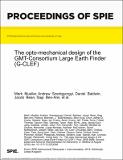The opto-mechanical design of the GMT-Consortium Large Earth Finder (G-CLEF)
Author(s)
Frebel, Anna L.
Download9908A2.pdf (1.135Mb)
PUBLISHER_POLICY
Publisher Policy
Article is made available in accordance with the publisher's policy and may be subject to US copyright law. Please refer to the publisher's site for terms of use.
Terms of use
Metadata
Show full item recordAbstract
The GMT-Consortium Large Earth Finder (G-CLEF) is a fiber-fed, optical echelle spectrograph selected as the first light instrument for the Giant Magellan Telescope (GMT) now under construction at the Las Campanas Observatory in Chile. G-CLEF has been designed to be a general-purpose echelle spectrograph with precision radial velocity (PRV) capability for exoplanet detection. The radial velocity (RV) precision goal of G-CLEF is 10 cm/sec, necessary for detection of Earth-sized exoplanets. This goal imposes challenging stability requirements on the optical mounts and the overall spectrograph support structures especially when considering the instrument's operational environment. The accuracy of G-CLEF's PRV measurements will be influenced by minute changes in temperature and ambient air pressure as well as vibrations and micro gravity-vector variations caused by normal telescope slewing. For these reasons we have chosen to enclose G-CLEF's spectrograph in a well-insulated, vibration isolated vacuum chamber in a gravity invariant location on GMT's azimuth platform. Additional design constraints posed by the GMT telescope include: a limited space envelope, a thermal emission ceiling, and a maximum weight allowance. Other factors, such as manufacturability, serviceability, available technology and budget are also significant design drivers. All of the above considerations must be managed while ensuring performance requirements are achieved. In this paper, we discuss the design of G-CLEF's optical mounts and support structures including the choice of a low coefficient of thermal expansion (CTE) carbon-fiber optical bench to minimize the system's sensitivity to thermal soaks and gradients. We discuss design choices made to the vacuum chamber geared towards minimize the influence of daily ambient pressure variations on image motion during observation. We discuss the design of G-CLEF's insulated enclosure and thermal control systems which will maintain the spectrograph at milli-Kelvin level stability while simultaneously limiting thermal emissions into the telescope dome. Also discussed are micro gravity-vector variations caused by normal telescope slewing, their uncorrected influence on image motion, and how they are dealt with in the design. Finally, we discuss G-CLEF's front-end assembly and fiber-feed system as well as other interface challenges presented by the telescope, enclosure and neighboring instrumentation.
Date issued
2016-08Department
Massachusetts Institute of Technology. Department of PhysicsJournal
Proceedings Volume 9908, Ground-based and Airborne Instrumentation for Astronomy VI
Publisher
SPIE
Citation
Mueller, Mark, et al. "The Opto-Mechanical Design of the GMT-Consortium Large Earth Finder (G-CLEF)." Proceedings Volume 9908, Ground-based and Airborne Instrumentation for Astronomy VI, 26 June - 1 July, 2016, Edinburgh, United Kindgom, edited by Christopher J. Evans et al., SPIE, 2016, p. 9908A2.
Version: Final published version